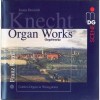Biography
Born: September 30, 1752 - Biberach an der Riss, Suabia (Baden-Württemberg), Germany
Died: December 1, 1817 - Biberach an der Riss, Suabia (Baden-Württemberg), Germany
Justin [Justinus] Heinrich Knecht was a German composer, organist, and music theorist. He received a good education, both musical and general (Boeckh was one of his masters). He learnt to play the organ, keyboard, violin, and singing in Biberach. He attended a Lutheran collegiate institution in Esslingen am Neckar from 1768 to 1771.
In 1771 J.H. Knecht became Lutheran preceptor (professor of Literature) and music director in Biberach, which was a free imperial city until 1803, and had a rich cultural life. He became organist of St Martin's church in 1792, which was used simultaneously by Lutherans and Catholics. He led an energetic, busy musical life; he composed for the theatre and church, organised subscription concerts, and taught music theory, acoustics, aesthetics, composition, and instruments at the Gymnasium, which was affiliated to the Musikschule in 1806. By degrees he gravitated to music, and December 1806 went to Stuttgart in the hopes of a post there as Kapellmeister or similar. In April 1807 he was appointed Direktor beim Orchester (director of the opera and of the court concerts) by King of Württemberg in the April 1807. Owing to successful intrigues against him, in a couple of years he resigned the post and returned to his former life in Biberach (1808), where he remained for the rest of his life. He died there where he died, with a great reputation as organist, composer and theoretician.
As a theoretician J.H. Knecht was an adherent of G.J. Vogler. The list of his productions as given in Q.-L. embraces many compositions, sacred and secular, vocal and instrumental, and eight theoretical and didactic works. Two of the former have an historical interest, and that from an accidental cause. The first is 'Le Portrait Musical de la Nature,' a grand symphony for two violins, viola and bass, two flutes, two oboes, bassoons, horns, trumpets and drums ad lib., in which is expressed:
(1) A beautiful country, the sun shining, gentle airs and murmuring brooks; birds twitter, a waterfall tumbles from the mountain, the shepherd plays his pipe, the shepherdess sings, and the lambs gambol around.
(2) Suddenly the sky darkens, an oppressive closeness pervades the air, black clouds gather, the wind rises, distant thunder Is heard, and the storm approaches.
(3) The tempest bursts in all Its fury, the wind howls and the rain beats, the trees .groan and the streams rush furiously.
(4) The storm gradually goes off, the clouds disperse and the sky clears.
(5) Nature raises its joyful voice to heaven in songs of gratitude to the Creator (a hymn with variations).
The second (if it be not an arrangement of a portion of the preceding) is another attempt of the same kind with a German title - 'The Shepherds' pleasure interrupted by the storm, a musical picture for the organ.' These are precisely the subjects which L.v. Beethoven has treated, and Fetis would have us believe that Knecht actually anticipated not only the general scheme of the Pastoral Symphony but some of its figures and passages. But this is not the case. Sir George Grove purchased the score and parts of J.H. Knecht's work at Otto Jahn's sale, and is able to say that beyond the titles the resemblances between the two works are obviously casual, Knecht's being in addition commonplace, entirely wanting in that' expression of emotions' which L.v. Beethoven enforces, and endeavouring to depict the actual sights and sounds, which he deprecates.
Collections are in the Wieland-Archiv, Biberach, and the Kick collection at the library of Eberhard-Karls-Universität, Tübingen. A full thematic catalogue is in Ladenburger (1984).







![Het Historische Orgel in Nederland [CD 14 of 20]](http://static.classicalm.com/repository/collection-cover/small/1007-img1343562180525462.jpg)
